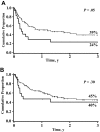Umbilical cord blood transplantation after nonmyeloablative conditioning: impact on transplantation outcomes in 110 adults with hematologic disease
- PMID: 17569820
- PMCID: PMC2018678
- DOI: 10.1182/blood-2007-04-067215
Umbilical cord blood transplantation after nonmyeloablative conditioning: impact on transplantation outcomes in 110 adults with hematologic disease
Abstract
We evaluated the efficacy of umbilical cord blood (UCB) in the setting of a nonmyeloablative regimen consisting of fludarabine (200 mg/m2), cyclophosphamide (50 mg/kg), and a single fraction of total body irradiation (200 cGy) with cyclosporine and mycophenolate mofetil for posttransplantation immunoprophylaxis. The target cell dose for the UCB graft was 3.0 x 10(7) nucleated cells/kg, resulting in the selection of a second partially human leukocyte antigen-matched UCB unit in 85%. One hundred ten patients with hematologic disease were enrolled. Neutrophil recovery was achieved in 92% at a median of 12 days. Incidences of grades III and IV acute and chronic graft-versus-host disease (GVHD) were 22% and 23%, respectively. Transplantation-related mortality was 26% at 3 years. Survival and event-free survival (EFS) at 3 years were 45% and 38%, respectively. Favorable risk factors for survival were absence of high-risk clinical features (Karnofsky 50-60, serious organ dysfunction, recent fungal infection, P < .01) and absence of severe GVHD (P = .04), and favorable risk factors for EFS were absence of high-risk clinical features (P < .01) and use of 2 UCB units (P = .07). These findings support the use of UCB after a nonmyeloablative conditioning as a strategy for extending the availability of transplantation therapy, particularly for older patients.
Figures




References
-
- Laughlin MJ, Eapen M, Rubinstein P, et al. Outcomes after transplantation of cord blood or bone marrow from unrelated donors in adults with leukemia. N Engl J Med. 2004;351:2265–2275. - PubMed
-
- Rocha V, Labopin M, Sanz G, et al. Transplants of umbilical-cord blood or bone marrow from unrelated donors in adults with acute leukemia. N Engl J Med. 2004;351:2276–2285. - PubMed
-
- Takahashi S, Iseki T, Ooi J, et al. Single-institute comparative analysis of unrelated bone marrow transplantation and cord blood transplantation for adult patients with hematologic malignancies. Blood. 2004;104:3813–3820. - PubMed
-
- di Grazia C, Raiola AM, Van Lint MT, et al. Conventional hematopoietic stem cell transplants from identical or alternative donors are feasible in recipients relapsing after an autograft. Haematologica. 2001;86:646–651. - PubMed
-
- Uzunel M, Remberger M, Sairafi D, et al. Unrelated versus related allogeneic stem cell transplantation after reduced intensity conditioning. Transplantation. 2006;82:913–919. - PubMed
Publication types
MeSH terms
Substances
Grants and funding
LinkOut - more resources
Full Text Sources
Other Literature Sources
Medical

